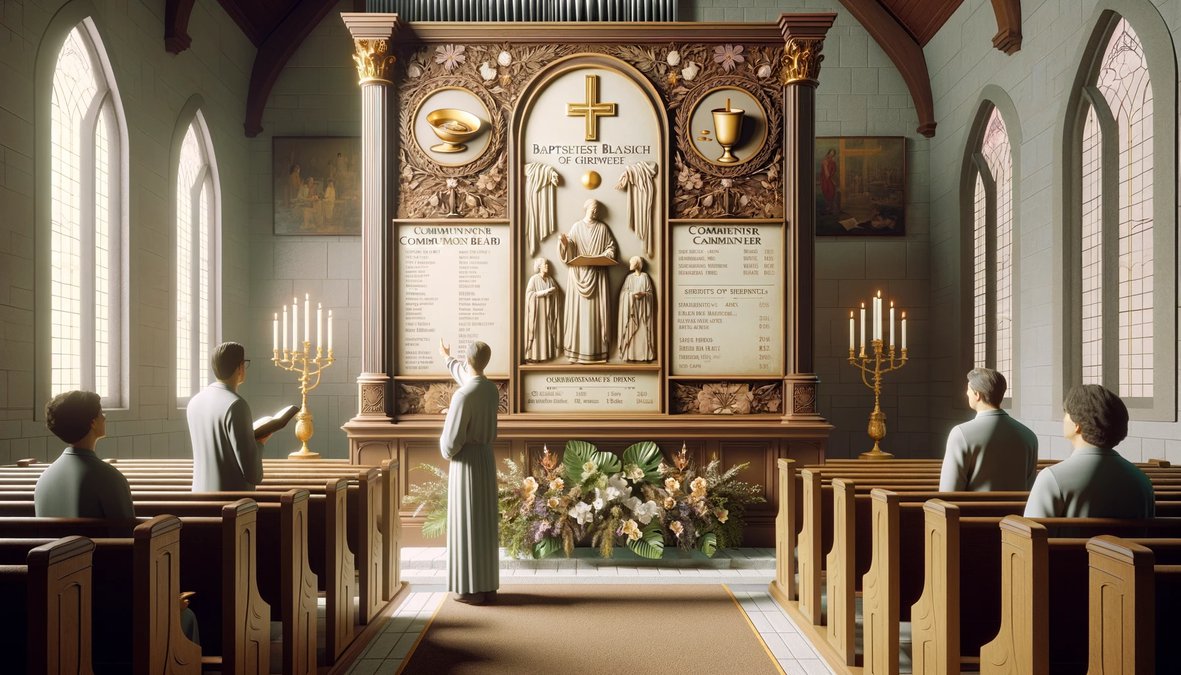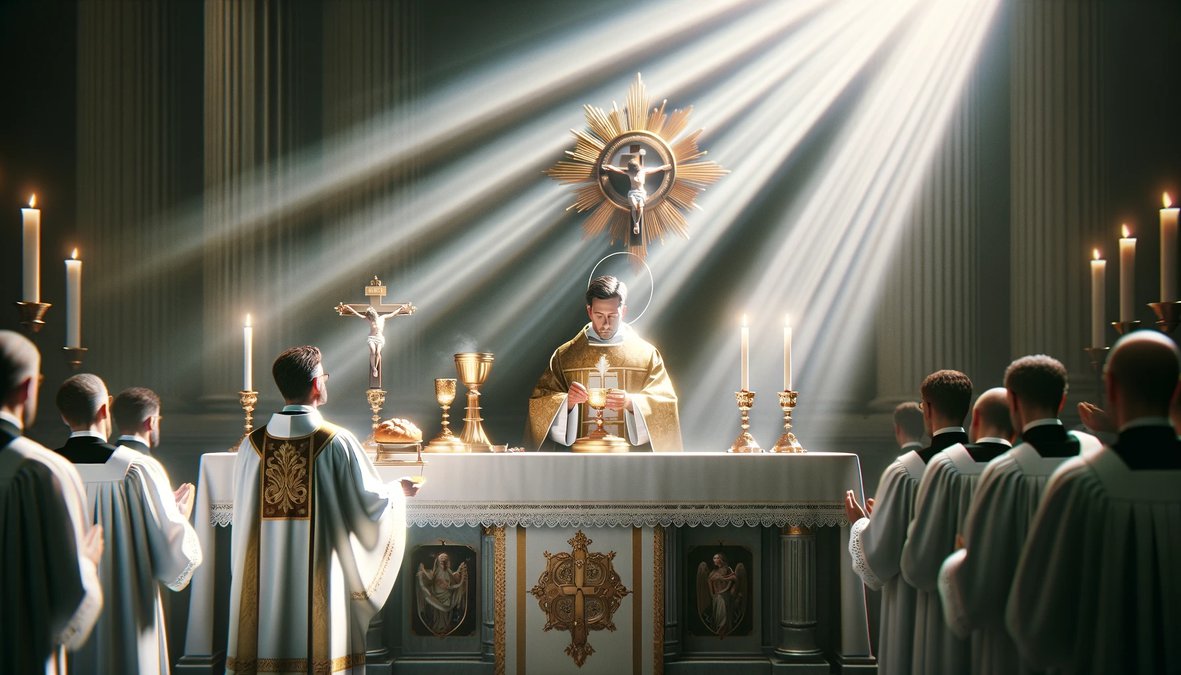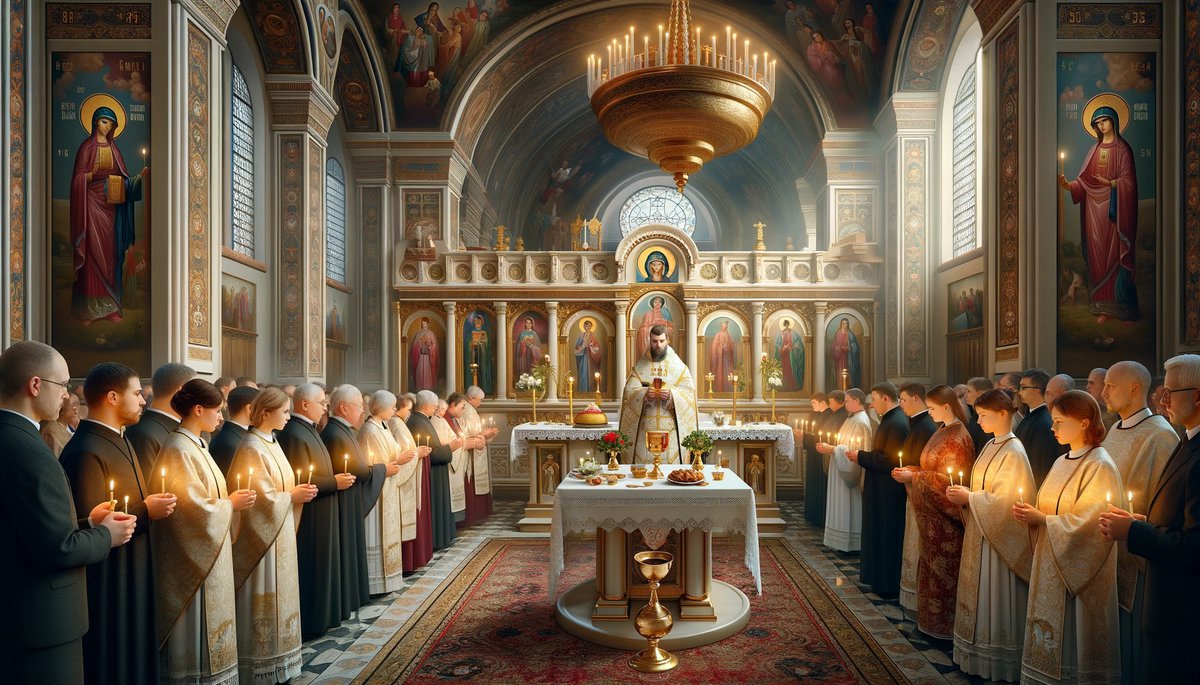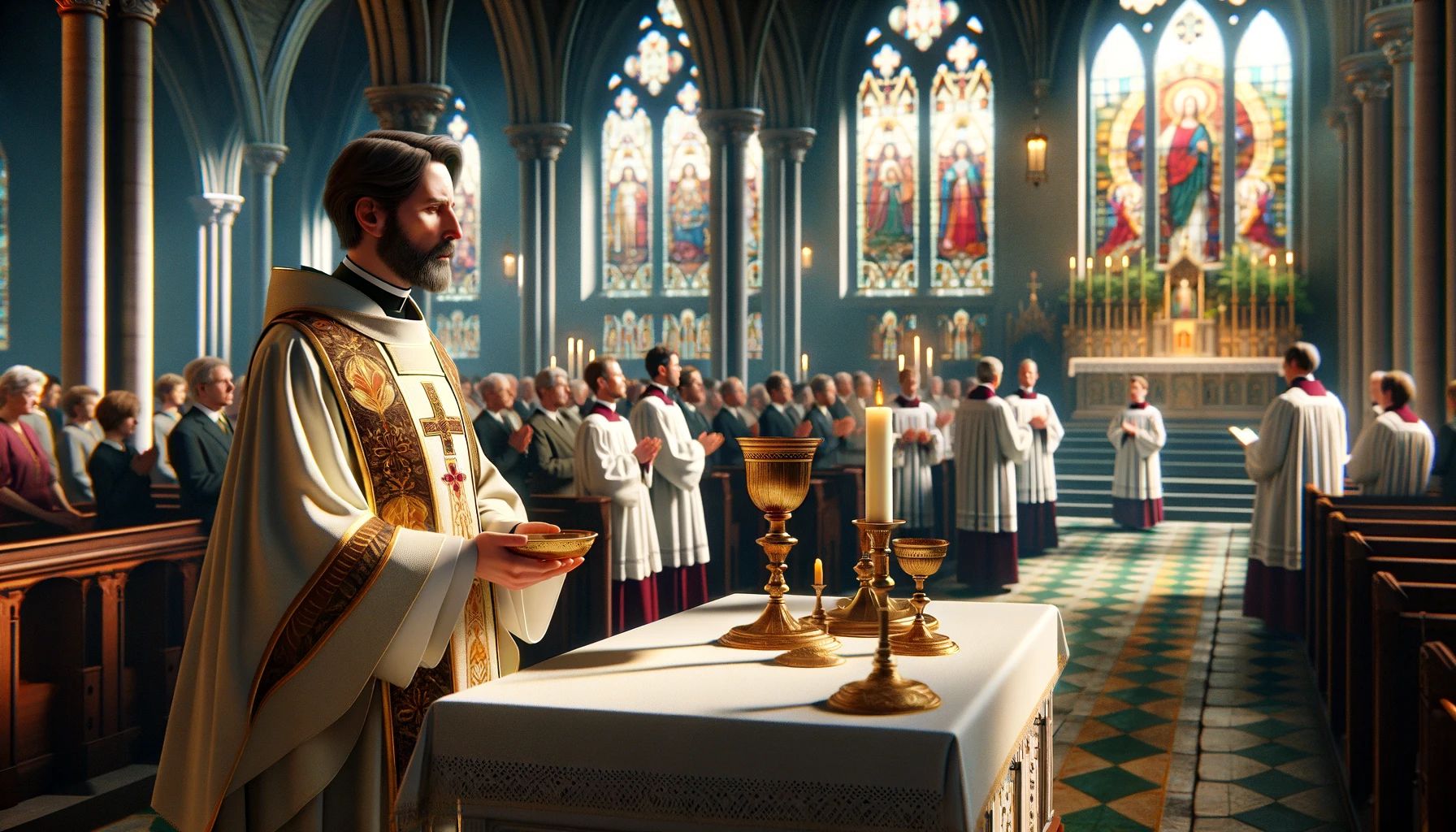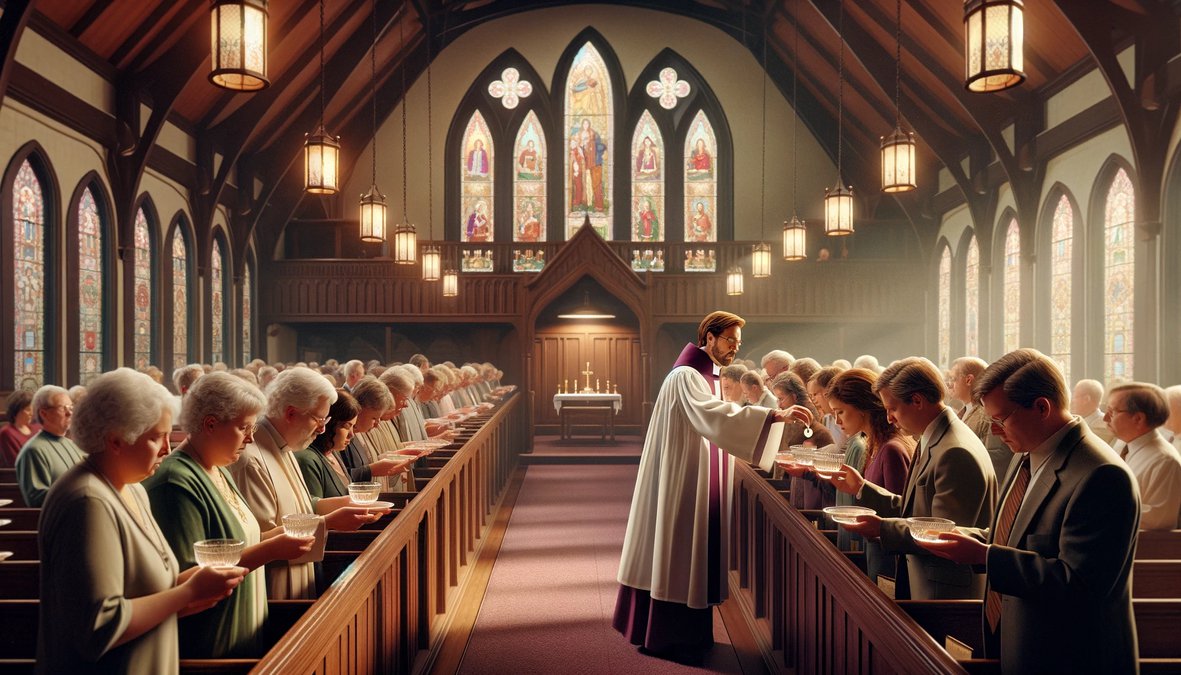Home>Theology and Spirituality>Eucharist: Cross Arms When Taking Communion


Theology and Spirituality
Eucharist: Cross Arms When Taking Communion
Published: February 19, 2024
Jason DeRose, Managing Editor at Christian.net, uses his expertise in religion and journalism to deepen understanding of faith's societal impacts. His editorial leadership, coupled with a strong academic background, enriches the platform’s diverse content, earning him recognition in both journalism and religious circles.
Learn the significance of crossing your arms when receiving communion and its connection to theology and spirituality. Explore the deeper meaning behind this sacred act.
(Many of the links in this article redirect to a specific reviewed product. Your purchase of these products through affiliate links helps to generate commission for Christian.net, at no extra cost. Learn more)
Table of Contents
Introduction
The Eucharist, also known as Holy Communion, is a central sacrament in many Christian traditions, symbolizing the spiritual nourishment and unity of believers with Christ and one another. It is a sacred ritual that holds deep significance for Christians worldwide, representing the body and blood of Jesus Christ. The act of receiving the Eucharist is a profound and reverent moment for believers, and it is often accompanied by various traditions and customs that enrich the spiritual experience.
In the context of receiving the Eucharist, the tradition of crossing one's arms has been observed by many individuals as a sign of reverence and respect. This practice, while not universally adopted, holds special meaning for those who choose to incorporate it into their communion ritual. Understanding the significance and reasons behind this tradition can provide valuable insights into the rich tapestry of customs that accompany the Eucharistic celebration.
As we delve into the tradition of crossing arms when taking communion, we will explore the historical and spiritual underpinnings of this practice, shedding light on its symbolism and the profound connection it fosters between the communicant and the divine. By gaining a deeper understanding of this tradition, we can appreciate the layers of meaning and reverence that infuse the act of receiving the Eucharist, enriching our spiritual journey and fostering a deeper connection with the sacred ritual.
Read more: When Not To Take Communion
The Significance of the Eucharist
The Eucharist holds profound significance within Christian theology and spirituality, serving as a cornerstone of the faith and a sacred sacrament that embodies the spiritual nourishment and unity of believers with Christ and one another. Rooted in the Last Supper, where Jesus shared bread and wine with his disciples, the Eucharist symbolizes the sacrificial love and redemptive grace of Christ, as well as the communal bond among believers.
At its core, the Eucharist represents the real presence of Jesus Christ, with the consecrated bread and wine believed to undergo a spiritual transformation into the body and blood of Christ. This concept, known as transubstantiation in Catholic theology, underscores the profound mystery and divine nature of the Eucharist, emphasizing the intimate union between the communicant and Christ himself.
Moreover, the Eucharist serves as a spiritual banquet, inviting believers to partake in the life-giving sustenance offered by Christ. Through the act of receiving the Eucharist, individuals are nourished spiritually, finding sustenance for their souls and experiencing a deep sense of communion with the divine. This sacred meal not only commemorates the sacrifice of Christ but also fosters a sense of unity and fellowship among believers, transcending individual experiences to form a collective bond within the body of Christ.
Furthermore, the Eucharist is a source of grace and spiritual renewal, offering believers the opportunity to encounter Christ in a tangible and transformative manner. By partaking in the Eucharistic celebration, individuals are invited to enter into a profound encounter with the living Christ, experiencing his love, mercy, and transformative power. This encounter serves as a spiritual nourishment, strengthening the faith of believers and deepening their connection to the redemptive work of Christ.
In essence, the Eucharist holds multifaceted significance, embodying the real presence of Christ, fostering communal unity, and offering spiritual nourishment and renewal to believers. Its rich symbolism and theological depth make the Eucharist a central and revered sacrament within Christian tradition, inviting believers to partake in the sacred mystery of Christ's presence and redemptive love.
The Tradition of Crossing Arms When Taking Communion
The tradition of crossing one's arms when taking communion is a practice observed by many individuals within certain Christian denominations. This custom, while not universally adopted, holds special significance for those who choose to incorporate it into their communion ritual. When approaching the altar to receive the Eucharist, individuals who opt to cross their arms often do so as a sign of reverence and respect for the sacred elements being offered.
The act of crossing one's arms during communion typically involves placing one's right hand on the left shoulder and the left hand on the right shoulder, creating a symbolic gesture of humility and openness before receiving the consecrated bread and wine. This posture is often accompanied by a bow of the head, further emphasizing the communicant's reverence and readiness to partake in the sacred ritual.
The tradition of crossing arms when taking communion is rooted in a deep sense of reverence for the Eucharist and a desire to approach the sacrament with humility and respect. By assuming this posture, individuals express their readiness to receive the body and blood of Christ with a spirit of contrition and openness, acknowledging the sacred nature of the Eucharistic feast.
Furthermore, the act of crossing arms during communion serves as a physical embodiment of the communicant's inner disposition, reflecting a heart that is prepared to encounter the real presence of Christ in the consecrated elements. This outward gesture of humility and reverence aligns with the spiritual significance of the Eucharist, emphasizing the communicant's desire to partake in the sacred meal with a spirit of awe and devotion.
The tradition of crossing arms when taking communion is a poignant reminder of the solemnity and sanctity of the Eucharistic celebration. It underscores the profound connection between the communicant and the divine, inviting individuals to approach the altar with a sense of reverence and humility. By embracing this tradition, believers seek to honor the sacred mystery of the Eucharist and to cultivate a deeper awareness of the transformative encounter with Christ that unfolds during the communion ritual.
In essence, the tradition of crossing arms when taking communion embodies a profound expression of reverence, humility, and spiritual readiness, enriching the experience of receiving the Eucharist and deepening the communicant's connection to the sacred mystery of Christ's presence in the sacrament.
Reasons for Crossing Arms During Communion
The act of crossing one's arms during communion holds deep significance, rooted in a myriad of reasons that enrich the spiritual experience of receiving the Eucharist. This profound gesture of reverence and humility embodies the communicant's inner disposition and serves as a tangible expression of their readiness to partake in the sacred ritual. Here are several compelling reasons for the tradition of crossing arms during communion:
-
Reverence for the Real Presence: Crossing arms during communion signifies a deep reverence for the real presence of Christ in the consecrated bread and wine. By assuming this posture, individuals express their acknowledgment of the sacred mystery unfolding before them, honoring the transformative encounter with the living Christ that takes place during the Eucharistic celebration.
-
Spiritual Readiness and Openness: The act of crossing arms represents a communicant's spiritual readiness and openness to receive the body and blood of Christ. This gesture symbolizes a heart that is prepared to encounter the divine, reflecting a posture of humility and receptivity before the sacred elements offered during the Eucharistic feast.
-
Sign of Contrition and Humility: Crossing one's arms serves as a visible sign of contrition and humility before approaching the altar to receive the Eucharist. This practice underscores the communicant's awareness of their own imperfections and the need for God's mercy, fostering a spirit of repentance and openness to the redemptive grace offered through the sacrament.
-
Acknowledgment of the Sacred Feast: By crossing their arms, individuals acknowledge the sacred nature of the Eucharistic feast and the profound significance of partaking in the body and blood of Christ. This gesture conveys a deep sense of respect for the spiritual banquet that unites believers with Christ and one another, emphasizing the solemnity and sanctity of the communion ritual.
-
Cultural and Personal Tradition: For many individuals, the tradition of crossing arms during communion is a cultural or personal expression of reverence and devotion. It may be rooted in familial customs, religious upbringing, or a personal spiritual connection to the act of receiving the Eucharist, adding a layer of personal significance to this reverent gesture.
In essence, the tradition of crossing arms during communion encompasses a tapestry of reasons, each contributing to the profound spiritual depth and reverence associated with the act of receiving the Eucharist. This tradition not only enriches the individual's experience of communion but also serves as a visible expression of their reverence for the real presence of Christ and their readiness to partake in the sacred mystery of the Eucharistic celebration.
How to Cross Arms When Taking Communion
When approaching the altar to receive the Eucharist, the act of crossing one's arms is a tangible expression of reverence and humility, signifying the communicant's readiness to partake in the sacred ritual. This solemn gesture, when performed with intention and mindfulness, embodies the communicant's inner disposition and serves as a visible sign of their spiritual readiness to encounter the real presence of Christ in the consecrated elements.
To cross arms when taking communion, one begins by placing the right hand on the left shoulder and the left hand on the right shoulder, creating a symbolic gesture of openness and receptivity. This posture reflects a heart that is prepared to receive the body and blood of Christ with reverence and contrition, acknowledging the sacred mystery unfolding during the Eucharistic celebration. Additionally, a slight bow of the head may accompany this gesture, further emphasizing the communicant's humility and respect for the sacred elements being offered.
The physical act of crossing arms during communion is a deeply personal and contemplative moment, allowing individuals to embody their spiritual disposition through a tangible gesture. It serves as a visual representation of the communicant's inner posture, conveying a sense of reverence, openness, and humility before the transformative encounter with the living Christ in the Eucharist.
Moreover, the act of crossing arms during communion is not merely a physical motion but a profound expression of the communicant's faith and devotion. It signifies a willingness to partake in the sacred feast with a spirit of awe and gratitude, recognizing the profound significance of encountering Christ in the Eucharistic elements. This reverent gesture enriches the communicant's experience of communion, fostering a deeper connection to the sacred mystery and the spiritual nourishment offered through the Eucharistic celebration.
In essence, the manner in which one crosses their arms when taking communion is a deeply personal and reverent act, embodying the communicant's spiritual disposition and their readiness to partake in the transformative encounter with the real presence of Christ. This tangible expression of reverence enriches the communion ritual, fostering a deeper sense of connection to the sacred mystery and the communal bond shared among believers in the Eucharistic celebration.
Read more: When Do Baptist Take Communion
Conclusion
The tradition of crossing arms when taking communion embodies a profound expression of reverence, humility, and spiritual readiness, enriching the experience of receiving the Eucharist and deepening the communicant's connection to the sacred mystery of Christ's presence in the sacrament. This solemn gesture, rooted in a deep sense of reverence for the Eucharist, serves as a tangible expression of the communicant's inner disposition and their readiness to partake in the sacred ritual.
Throughout the centuries, the act of crossing arms during communion has held deep significance for many individuals within various Christian denominations. It symbolizes a heart that is prepared to encounter the real presence of Christ in the consecrated elements, reflecting a posture of humility and receptivity before the sacred feast. This tradition is a poignant reminder of the solemnity and sanctity of the Eucharistic celebration, emphasizing the profound connection between the communicant and the divine.
The reasons for crossing arms during communion are multifaceted, encompassing a tapestry of spiritual depth and reverence. From acknowledging the real presence of Christ to expressing contrition and humility, this tradition enriches the individual's experience of communion and serves as a visible expression of their reverence for the sacred mystery unfolding before them. It fosters a deeper connection to the transformative encounter with the living Christ, inviting individuals to approach the altar with a sense of reverence and openness.
In essence, the tradition of crossing arms when taking communion invites believers to embody their spiritual disposition through a tangible gesture, fostering a deeper connection to the sacred mystery and the communal bond shared among believers in the Eucharistic celebration. It serves as a visual representation of the communicant's inner posture, conveying a sense of reverence, openness, and humility before the transformative encounter with the real presence of Christ in the Eucharist.
As individuals continue to engage in the rich tapestry of customs and traditions surrounding the Eucharist, the practice of crossing arms during communion stands as a timeless symbol of reverence and spiritual readiness, enriching the sacred experience of receiving the body and blood of Christ. This tradition, rooted in deep reverence and humility, serves as a poignant reminder of the sacred mystery and the profound connection between the communicant and the divine, inviting believers to approach the Eucharistic celebration with awe, gratitude, and a deep sense of spiritual readiness.
